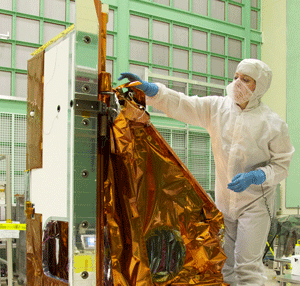C reative
Particle
Higgs
CPH Theory is based on Generalized light velocity from energy into mass.
CPH Theory in Journals
|
NASA’s QWIP-based Thermal Infrared Sensor to be integrated into Landsat satellite
|
|
15 February 2012
A new satellite instrument made by the US National Aeronautics and Space Administration (NASA) that uses gallium arsenide (GaAs)-based quantum-well infrared photodetector (QWIP) technology has arrived at Orbital Sciences Corp in Gilbert, AZ, USA, where it will be integrated into the next Landsat satellite, the Landsat Data Continuity Mission (LDCM). Picture: Aleksandra Bogunovic reaches across the TIRS instrument to affix the corners of a Multi-Layer Insulation blanket. (Credit: NASA Goddard/Rebecca Roth). The Thermal Infrared Sensor (TIRS) instrument will measure the Earth’s temperature with technology that applies quantum physics to detect heat. The engineering team at NASA’s Goddard Space Flight Center in Greenbelt, MD completed TIRS on an accelerated schedule, going from plans on paper to building the instrument in an unprecedented 43 months. “That’s a full year ahead of a typical schedule for a new space-borne instrument,” notes TIRS instrument manager Betsy Forsbacka.
The achievement has been enabled by the use of detector arrays that LDCM had on-hand, since Goddard played a major role in developing the technology, says LDCM project scientist James Irons. “TIRS will be the first time this technology is used in space,” he adds. TIRS uses QWIP devices to detect long wavelengths of light emitted by the Earth with an intensity that depends on surface temperature. The thermal infrared wavelengths are well beyond the range of human vision and, while devices for thermal infrared night ‘vision’ have long been available, QWIPs offer a new lower-cost alternative to conventional infrared technology. Also, QWIP arrays are designed for sensitivity to specific wavelengths. The QWIP’s design operates on the principles of quantum mechanics. GaAs chips trap electrons in an energy state ‘well’ until the electrons are elevated to a higher state by thermal infrared light of a certain wavelength. The elevated electrons create an electrical signal that can be read out and recorded to create a digital image. The QWIPs that TIRS uses are sensitive to two thermal infrared wavelength bands, helping it separate the temperature of the Earth’s surface from that of the atmosphere. TIRS was added to the satellite mission when it became clear that state water resource managers rely on the highly accurate measurements of Earth’s thermal energy obtained by NASA satellites (such as LDCM’s predecessors Landsat 5 and Landsat 7) to track how land and water are being used. “For example, irrigated fields are cooler than those suffering from a lack of moisture,” says TIRS thermal engineer Veronica Otero. With nearly 80% of the fresh water in the Western USA being used to irrigate crops, TIRS will become an invaluable tool for managing water consumption, says Rick Allen, director of water resources research at the University of Idaho, in Kimberly, ID. LDCM is scheduled to launch in January 2013 from Vandenberg Air Force Base in California. On board will be two instruments: TIRS and the Operational Land Imager (OLI) imaging sensor built by Ball Aerospace & Technologies Corp of Boulder, CO, which collects data in the visible, near-infrared and short-wave infrared spectrum. LDCM is the eighth satellite in the Landsat series, which began in 1972 with the launch of Landsat 1, and extends the world’s longest-running satellite program for global land observations. Landsat is jointly managed by NASA and the US Department of the Interior through the US Geological Survey (USGS, which preserves a 40-year archive of Landsat images, with free distribution of data over the Internet). Because of this freely available data of more than 3 million current and archived images of Earth, Landsat data is the basis for thousands of university research papers, the foundation for commercial innovations like Google Earth, and a cornerstone of US space cooperation with foreign nations. More than 20 nations on six continents operate local receiving stations for Landsat data.
Source: Semiconductor
1 2 3 4 5 6 7 8 9 10 Newest articles
|
|
Sub quantum space and interactions from photon to fermions and bosons |
Interesting articles
Since 1962 I doubted on Newton's laws. I did not accept the infinitive speed and I found un-vivid the laws of gravity and time.
I learned the Einstein's Relativity, thus I found some answers for my questions. But, I had another doubt of Infinitive Mass-Energy. And I wanted to know why light has stable speed?

